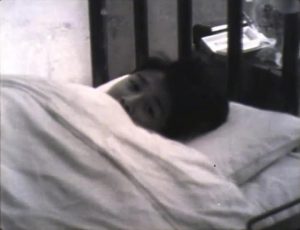Striving to fill voids in Hiroshima, evidence of victims remains—Screenplay of Mugen-no-Hitomi, movie about student who died of leukemia after Hiroshima A-bombing
Mar. 19, 2023
Starting point of movement involving folded paper cranes
by Kyosuke Mizukawa, Senior Staff Writer
A screenplay written for a documentary film titled Mugen-no-Hitomi (in English, ‘Infinite Eyes’), filmed and released in 1955, was found to still exist. The film told the story of a high school student in Tokyo who died of leukemia at the age of 18, a decade after he had experienced the atomic bombing in Hiroshima. The documentary introduced to a nationwide audience the existence of young A-bomb survivors suffering from leukemia, a disease whose incidence spiked after exposure to radiation from the atomic bombings, which in turn led to an initiative involving the donation of 1,000 folded paper cranes to Hiroshima. As of this writing, March 19, two months remain before the summit meeting of the G7 (Group of Seven industrialized nations) in Hiroshima. The screenplay represents valuable information relating to the history of folded paper cranes, which have become the symbol of the A-bombed city’s hopes for peace.
The student depicted in the film is Makoto Chiba, who experienced the atomic bombing in Hiroshima before his family moved to Tokyo. In the fall of 1954, Mr. Chiba, then a third-year student at Seijo High School, in Shinjuku, Tokyo, was hospitalized to undergo treatment for leukemia, which was thought to have been caused by his earlier exposure to A-bomb radiation. To expand support for Mr. Chiba, the school’s student council decided to make the movie. Twenty minutes in length, the film documents Mr. Chiba’s stay in the hospital, a donation campaign led by the students, and the funeral organized by the school for Mr. Chiba after he died in May 1955, at a time when the film’s production was still unfinished.
The film screenplay has been kept on hand by Eizo Kote, 85, a resident of Tokyo who was engaged in the film-making process as a member of the student council. The manuscript contains lines calling for opposition to the use of atomic and hydrogen bombs. “Use of atomic and hydrogen bombs will create a second or third person like you,” is one such line of protest. The film has been uploaded by Seijo High School to YouTube, the online video platform. Mr. Kote will donate the screenplay manuscript to the Hiroshima Peace Memorial Museum, located in the city’s Naka Ward, in the hopes that it can receive more recognition.
The film was first screened at an event related to the first World Conference against Atomic & Hydrogen Bombs, held in Hiroshima in August 1955. With newspapers and magazines also reporting on the film, the screening helped expand among younger people the activities taking place at the time calling for support of A-bomb survivors.
In the summer of 1955, students from Aichi Shukutoku Senior High School, in Nagoya City, sent one-thousand paper cranes to the Hiroshima Red Cross Hospital in Hiroshima as part of get-well wishes intended for A-bomb survivors who had developed leukemia like Mr. Chiba. A young girl named Sadako Sasaki received some of the paper cranes while in the hospital as she underwent treatment for leukemia. That experience prompted her to start folding paper cranes herself.
Sadako, who died in October of the same year at the age of 12, later served as the model for the Children’s Peace Monument, erected in Peace Memorial Park in 1958. The paper cranes she folded in hopes of recovery from the disease have become iconic exhibits at the Peace Memorial Museum, located in the park. Japan’s national government is now making plans for global leaders in attendance at the Hiroshima G7 summit (to be held May 19–21) to visit the museum.
(Originally published on March 19, 2023)









